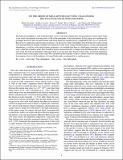| dc.contributor.author | Stakhiv, Mark | |
| dc.contributor.author | Landi, Enrico | |
| dc.contributor.author | Lepri, Susan T. | |
| dc.contributor.author | Oran, Rona | |
| dc.contributor.author | Zurbuchen, Thomas H. | |
| dc.date.accessioned | 2015-04-24T17:03:43Z | |
| dc.date.available | 2015-04-24T17:03:43Z | |
| dc.date.issued | 2015-03 | |
| dc.date.submitted | 2014-08 | |
| dc.identifier.issn | 1538-4357 | |
| dc.identifier.issn | 0004-637X | |
| dc.identifier.uri | http://hdl.handle.net/1721.1/96793 | |
| dc.description.abstract | The bimodal paradigm of solar wind describes a slow solar wind situated near the heliospheric current sheet while a fast wind overexpands from the poles to fill in the remainder of the heliosphere. In this paper, we challenge this paradigm and focus here on mid-latitude wind using three fast-latitude passes completed by the Ulysses spacecraft. Based on its composition and dynamic properties, we discuss how this wind differs from both the fast, polar coronal hole wind and the low latitude, streamer-associated slow solar wind. Using a detailed analysis of ionic and elemental abundances, as well as solar wind dynamic properties, we conclude that there is a third quasi-stationary solar wind state, called the boundary wind. This boundary wind is characterized by a charge-state distribution that is similar to slow wind, but with an elemental composition that is coronal hole like. Based on these data, we present arguments for the location of the origin of this wind. We conclude that the boundary wind is a subset of the fast wind emanating from regions close to the boundaries of coronal holes and is accelerated by a similar process. | en_US |
| dc.language.iso | en_US | |
| dc.publisher | IOP Publishing | en_US |
| dc.relation.isversionof | http://dx.doi.org/10.1088/0004-637X/801/2/100 | en_US |
| dc.rights | Article is made available in accordance with the publisher's policy and may be subject to US copyright law. Please refer to the publisher's site for terms of use. | en_US |
| dc.source | IOP Publishing | en_US |
| dc.title | ON THE ORIGIN OF MID-LATITUDE FAST WIND: CHALLENGING THE TWO-STATE SOLAR WIND PARADIGM | en_US |
| dc.type | Article | en_US |
| dc.identifier.citation | Stakhiv, Mark, Enrico Landi, Susan T. Lepri, Rona Oran, and Thomas H. Zurbuchen. “ON THE ORIGIN OF MID-LATITUDE FAST WIND: CHALLENGING THE TWO-STATE SOLAR WIND PARADIGM.” The Astrophysical Journal 801, no. 2 (March 10, 2015): 100. © 2015 The American Astronomical Society | en_US |
| dc.contributor.department | Massachusetts Institute of Technology. Department of Earth, Atmospheric, and Planetary Sciences | en_US |
| dc.contributor.mitauthor | Oran, Rona | en_US |
| dc.relation.journal | The Astrophysical Journal | en_US |
| dc.eprint.version | Final published version | en_US |
| dc.type.uri | http://purl.org/eprint/type/JournalArticle | en_US |
| eprint.status | http://purl.org/eprint/status/PeerReviewed | en_US |
| dspace.orderedauthors | Stakhiv, Mark; Landi, Enrico; Lepri, Susan T.; Oran, Rona; Zurbuchen, Thomas H. | en_US |
| dc.identifier.orcid | https://orcid.org/0000-0001-6419-552X | |
| mit.license | PUBLISHER_POLICY | en_US |
| mit.metadata.status | Complete | |
